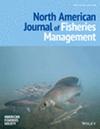比较环境 DNA 和水下目测计数调查,以检测小河流中的幼年科霍鲑
IF 1.4
4区 农林科学
Q3 FISHERIES
引用次数: 0
摘要
本研究比较了在加利福尼亚北部河流中使用环境 DNA(eDNA)技术和水下目测计数(UVC)调查检测到幼年科霍鲑 Oncorhynchus kisutch 的概率。在这里,UVC 调查的检测概率 (p) 通常超过 0.90,为检验较新的 eDNA 方法的性能提供了理想的环境。我们还评估了使用 eDNA 浓度来预测池塘栖息地中库荷马鲑数量的潜力。方法我们在加利福尼亚州史密斯河流域 25 个河段的 96 个池塘中进行了配对 eDNA 和 UVC 调查。我们使用多尺度占据模型估算了特定方法的 p 值和环境协变量的影响。我们使用广义线性模型来评估鱼类数量与 eDNA 浓度和生境协变量之间的关系。结果eDNA 和 UVC 方法在检测水池(93% 的一致率)和调查范围(80% 的一致率)内是否存在库荷鲑方面显示出高度的一致性。eDNA (peDNA) 和 UVC (pUVC) 的检测概率相似,且在水池剩余深度和流域面积的中位数水平上都很高(peDNA = 91%,pUVC = 89%)。汇水盆地面积(排水量的代表)具有强烈的负面影响,对 peDNA 的影响比对 pUVC 的影响更明显(例如,在最大的盆地中,peDNA = 34%,而 pUVC = 77%)。这项研究表明,在 36 平方公里的流域中,eDNA 方法与 UVC 调查的结果几乎相同,是确定鲑鱼分布的有效方法。不过,在使用 eDNA 估算小水池中的相对丰度之前,还需要进行更多的调查。本文章由计算机程序翻译,如有差异,请以英文原文为准。
Comparison of environmental DNA and underwater visual count surveys for detecting juvenile Coho Salmon in small rivers
ObjectiveThis study compares the probability of detecting juvenile Coho Salmon Oncorhynchus kisutch using both environmental DNA (eDNA) techniques and underwater visual count (UVC) surveys in northern California rivers. Here, UVC surveys commonly have detection probabilities (p ) surpassing 0.90, providing an ideal setting to examine the performance of newer eDNA methods. We also evaluate the potential for using eDNA concentrations to predict the count of Coho Salmon within pool habitats.MethodsWe conducted paired eDNA and UVC surveys in 96 pools across 25 stream reaches within the Smith River basin, California. Method‐specific p and the effect of environmental covariates were estimated using multiscale occupancy modeling. We used generalized linear models to evaluate the relationship of fish counts to eDNA concentrations and habitat covariates.ResultThe eDNA and UVC methods showed a high degree of agreement in detecting the presence of Coho Salmon within a pool (93% agreement) and survey reach (80% agreement). Detection probabilities for eDNA (p eDNA ) and for UVC (p UVC ) were similar and high at median levels of pool residual depth and contributing basin area (p eDNA = 91%, p UVC = 89%). Contributing basin area (a proxy for discharge) had a strong, negative effect that was more pronounced for p eDNA than for p UVC (e.g., in the largest basins, p eDNA = 34% whereas p UVC = 77%). We did not find eDNA concentrations to be a good predictor of Coho Salmon counts in small pools.ConclusionThis study demonstrates that eDNA methods yielded nearly identical results to UVC surveys in catchments <36 km2 and can provide a highly effective approach for determining the distribution of Coho Salmon. However, additional investigation is required before eDNA could be used to estimate relative abundance in small pools.
求助全文
通过发布文献求助,成功后即可免费获取论文全文。
去求助
来源期刊
CiteScore
2.60
自引率
18.20%
发文量
118
审稿时长
2 months
期刊介绍:
The North American Journal of Fisheries Management promotes communication among fishery managers with an emphasis on North America, and addresses the maintenance, enhancement, and allocation of fisheries resources. It chronicles the development of practical monitoring and management programs for finfish and exploitable shellfish in marine and freshwater environments.
Contributions relate to the management of fish populations, habitats, and users to protect and enhance fish and fishery resources for societal benefits. Case histories of successes, failures, and effects of fisheries programs help convey practical management experience to others.

 求助内容:
求助内容: 应助结果提醒方式:
应助结果提醒方式:


